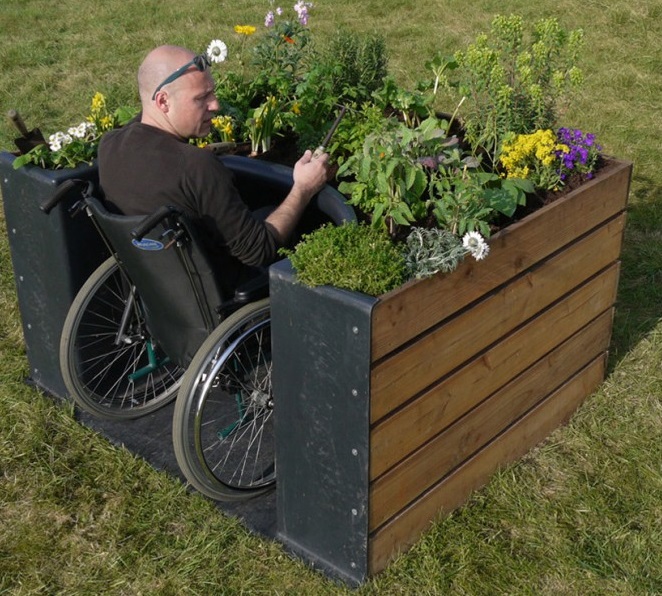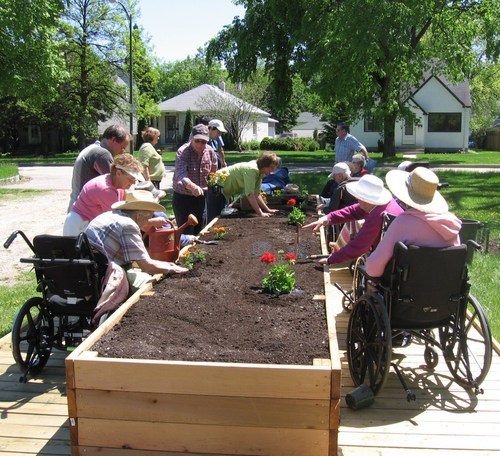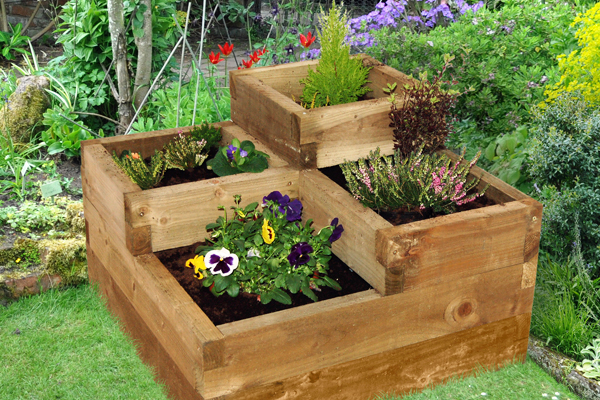English/Malay
Introduction
Taman Aman is one of my favourite place to go for a walk; one thing that attracts me to this place is the fact that it is OKU-friendly. For those who are not from Malaysia, OKU is short for Orang Kelainan Upaya a.k.a people with dis- or different ability.
I would have to say, Taman Aman is the first public place that I've noted to be OKU-friendly (pretty sure there's more) so kudos to MBPJ for taking a step forward towards "Accessible Park".
The term "Accessible" e.g. Accessible Park or Accessible Garden means that the place can be accessed, enjoyed and utilized by people with different kind of abilities. Just because one lack of an ability, doesn't mean that he or she could not enjoy certain activities, like gardening.
I have written before, albeit briefly that people with different ability can garden, just need the right approach.
In this writing, I'm going to explore how to create a Wheelchair Friendly Garden.
The term "Wheelchair Friendly Garden" has two different meanings;
I would have to say, Taman Aman is the first public place that I've noted to be OKU-friendly (pretty sure there's more) so kudos to MBPJ for taking a step forward towards "Accessible Park".
The term "Accessible" e.g. Accessible Park or Accessible Garden means that the place can be accessed, enjoyed and utilized by people with different kind of abilities. Just because one lack of an ability, doesn't mean that he or she could not enjoy certain activities, like gardening.
I have written before, albeit briefly that people with different ability can garden, just need the right approach.
In this writing, I'm going to explore how to create a Wheelchair Friendly Garden.
The term "Wheelchair Friendly Garden" has two different meanings;
- A garden that is accessible for a wheelchair user to visit.
- A garden that is accessible for a wheelchair user to garden.
 |
| Example of a wheelchair-friendly garden with wide, even and curvy path, and raised beds. Image source: Permaculture Research Institute. |
Who can benefits from having Wheelchair Friendly Garden?
Actually everyone, but perhaps more so for wheelchair users including the elders
2. Path. Similar to door/gate, the width of the paths in the garden have to be wide enough for a wheelchair to pass by easily in addition to a level pathway. If the garden has different levels, adding a ramp is advisable to facilitate movement between these levels. Moreover, it is recommended for the path to have gradual, easy curves, instead of sharp corners.
What are the Criteria for a Garden that is Wheelchair Friendly?
1. Door/Gate. Make sure that the width of the door is wide enough for a wheelchair to fit through easily when entering and exiting, in addition to the absence of threshold (small step at the base of the door).
 |
| Example of a wheelchair-friendly greenhouse. Note the width of the door and the absence of a threshold. Image source: Primrose.co.uk. |
2. Path. Similar to door/gate, the width of the paths in the garden have to be wide enough for a wheelchair to pass by easily in addition to a level pathway. If the garden has different levels, adding a ramp is advisable to facilitate movement between these levels. Moreover, it is recommended for the path to have gradual, easy curves, instead of sharp corners.
 |
| A ramp for multi-levels garden. Image source: Trusted Tree Surgeons. |
3. Raised Beds. Having raised beds in a garden will save a wheelchair-user from bending, an act which will put a strain on the back. However, the shape, width and height of a raised bed may differ from one wheelchair-user to another; so build one that suits you the best. Nevertheless, it is important to build a wide path surrounding the beds to allow rooms for movements. carryongardening.org.uk has written a very nice guideline on how to build a raised bed which you can see it here.
If you wish to see more about other raised beds, check here. I loved all of them and hopefully one day, I'll acquire at least one of them, especially this one;
4. Potting Bench, or potting station is a place to do gardening jobs (e.g. potting or looking after cuttings and seedlings) as well as great place to store gardening tools and unused pots.
Having a potting bench would be great; at the moment my seedlings are at a different place, I potter in a different place and my soil is placed at a different place...so they are scattered. Having a potting bench would means that all of my gardening stuffs in one place and only one place will get dirty and messy.
5. Tools and Planters. Tools are essential for gardening thus it is highly recommended to use lightweight tools and planters. A lightweight tool will not tire you easily whereas a lightweight planters (or pots) are easy to move and save a lot of strain on your back when you need to re-position them. Find tools that suits you the best that strain the least.
6. Organized. This is the most important criteria of all; having an organized and clean garden means less clutter hence less accident. This include utilities such as water pipe head; one suggestion I've read was to put pipe head in strategic places so you don't have to travel far or use a long water hose that might cause an accident.
To be honest, this answer is purely theoretical but if I were to recommend, I would recommend to start small (a table, a pot, one packet of soil and a packet of seeds) and begin with one plant; if you like herb, start with basil/cuban oregano, or ross moss for flowers and papaya/mulberry for fruits (these are the plants that I've work with). Actually, pineapple is not so bad; once the crown has grown roots and planted in a bigger pot, there's nothing to be done, but I'm not sure if it's the right plant to be recommended. From one plant, build up the familiarity with gardening habits and confidence before move on to the next plant that you like and so on and so forth.
 |
| This is called Terraform Wheelchair Accessible Garden. Image source: livingmadeeasy.org.uk. |
 |
| This is called Green Circle Raised Bed Garden. It is fascinating as it combines Raised Bed + Hydroponics. Image source: Green Circle Garden. |
 |
| Honestly, I like this picture. I think it would be fun for the elders to sit and potter around with friends. Image source: Tumblr. |
If you wish to see more about other raised beds, check here. I loved all of them and hopefully one day, I'll acquire at least one of them, especially this one;
 |
| Tiered Raised Bed. I can plant fruit tree in the tallest one; corn or tomato in the medium one, greens like broccoli in the lowest bed...oh I forgot sunflower, asparagus...😜 Image source: wonkeedonkeeforestgarden.co.uk. |
 |
| Example of a potting bench. Image source: Primrose.co.uk. |
Having a potting bench would be great; at the moment my seedlings are at a different place, I potter in a different place and my soil is placed at a different place...so they are scattered. Having a potting bench would means that all of my gardening stuffs in one place and only one place will get dirty and messy.
5. Tools and Planters. Tools are essential for gardening thus it is highly recommended to use lightweight tools and planters. A lightweight tool will not tire you easily whereas a lightweight planters (or pots) are easy to move and save a lot of strain on your back when you need to re-position them. Find tools that suits you the best that strain the least.
 |
| An example of a tool suited for a wheelchair user. Image source: nmeda. |
6. Organized. This is the most important criteria of all; having an organized and clean garden means less clutter hence less accident. This include utilities such as water pipe head; one suggestion I've read was to put pipe head in strategic places so you don't have to travel far or use a long water hose that might cause an accident.
Where to Start?
If there's a wheelchair user who wants to start gardening, where to begin?To be honest, this answer is purely theoretical but if I were to recommend, I would recommend to start small (a table, a pot, one packet of soil and a packet of seeds) and begin with one plant; if you like herb, start with basil/cuban oregano, or ross moss for flowers and papaya/mulberry for fruits (these are the plants that I've work with). Actually, pineapple is not so bad; once the crown has grown roots and planted in a bigger pot, there's nothing to be done, but I'm not sure if it's the right plant to be recommended. From one plant, build up the familiarity with gardening habits and confidence before move on to the next plant that you like and so on and so forth.
Conclusion
The six criteria that I've written are just general guidelines; as I read on the subject, there's more variations to how it is carried out. I am genuinely surprised and pleased at how much have been written and innovated regarding this topic as this means that more and more awareness has been raised regarding the needs of people with different abilities.Author's Note
If any of my readers who is an OKU or having experience working with OKU, and think that there's a mistake I've made in my writing, do not hesitate to correct me as I'm still learning though I always try my best to ensure that any information that I've written is accurate and relevant to the topic.Reference
2. Creating an Accessible Garden for Disabled Gardeners.
3. More references in the contents 😈
3. More references in the contents 😈
Ulasan
Catat Ulasan